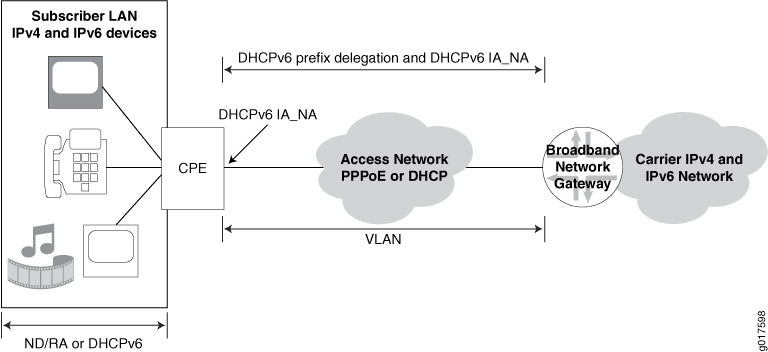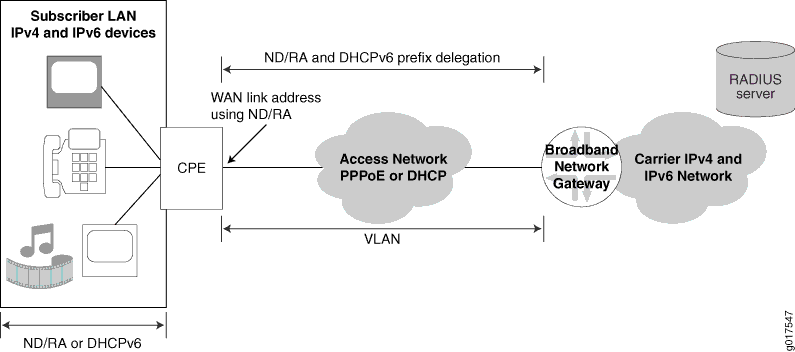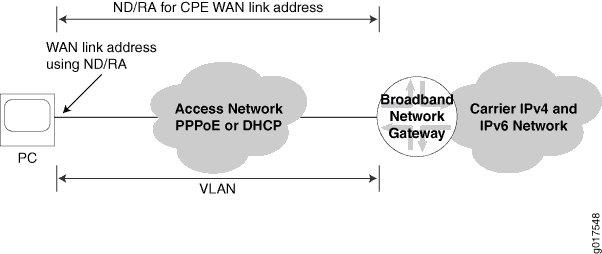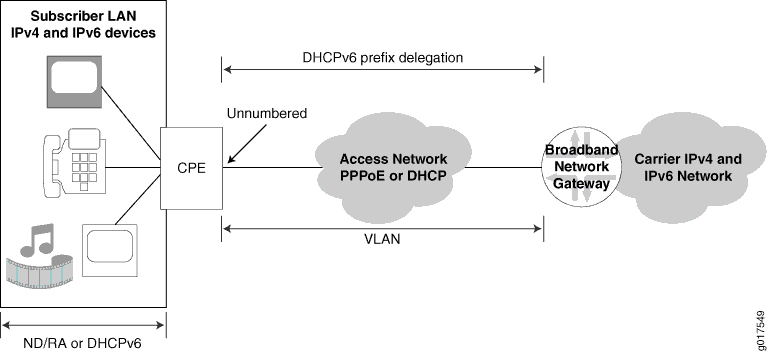ON THIS PAGE
Selecting the Method of Provisioning a Global IPv6 Address for the WAN Link
Selecting the Method of Assigning Global IPv6 Addresses to Subscribers
Design 1: IPv6 Addressing with DHCPv6 IA_NA and DHCPv6 Prefix Delegation
Design 2: IPv6 Addressing with NDRA and DHCPv6 Prefix Delegation
Design 4: IPv6 Addressing with DHCPv6 Prefix Delegation and No NDRA Prefix
Designs for IPv6 Addressing in a Subscriber Access Network
Selecting the Type of Addressing Used on the CPE
In some networks, you do not need to assign a global IPv6 address on the CPE WAN link. Your decision depends on the type of CPE being used:
If the CPE is purchased by the subscriber, and is not a device specifically recommended by the service provider, you need to assign a global IPv6 address that can be routed on the Internet.
If the CPE is supplied by or recommended by the service provider, you can use the loopback interface to manage the CPE.
In this case, you can use a link-local address or you can use an address that is derived from DHCPv6 prefix delegation.
See Also
Selecting the Method of Provisioning a Global IPv6 Address for the WAN Link
To assign a global IPv6 address to the WAN link of the CPE device, you can choose one of the methods described in Table 1.
NDRA Features |
DHCPv6 IA_NA Features |
|---|---|
Provides address autoconfiguration of the WAN link by means of router advertisements. |
Provides a single IPv6/128 address to the WAN interface of the CPE by the BNG acting as a DHCPv6 server. |
Supported on PPPoE access networks. |
Supported on PPPoE and DHCP access networks. |
Provides duplicate prefix prevention. |
Provides the ability to use one DHCPv6 message to solicit both a global IPv6 address for the WAN link, and a prefix used to provision addresses on the subscriber LAN. |
Use if the CPE does not support DHCP. |
-- |
See Also
Selecting the Method of Assigning Global IPv6 Addresses to Subscribers
For addressing on the subscriber LAN, we recommend that you provision a global IP address for each device on the LAN. IPv6 was designed to allow every IP-capable device on a subscriber LAN to obtain a globally unique address, which avoids the use of NAT between the subscriber LAN and the service provider.
DHCPv6 prefix delegation automates the delegation of IPv6 prefixes to the CPE. The CPE can then use these prefixes to assign global IPv6 addresses for use in a subscriber LAN. DHCPv6 prefix delegation is useful when the delegating router (the BNG) does not have information about the topology of the networks in which the requesting router (the CPE) is located. In such cases, the delegating router requires only the identity of the requesting router to choose a prefix for delegation.
See Also
Selecting the Method of Obtaining IPv6 Prefixes
You can set up the BNG to select IPv6 prefixes through one of the following methods:
An external source such as a AAA RADIUS server or a DHCP server using the DHCPv6 relay agent.
Dynamic assignment from a local pool of global IPv6 addresses or prefixes that is configured on the BNG
- Using a AAA RADIUS Server to Obtain Global IPv6 Addresses and IPv6 Prefixes
- Using a Local Pool to Assign IPv6 Addresses or Prefixes
Using a AAA RADIUS Server to Obtain Global IPv6 Addresses and IPv6 Prefixes
Table 2 describes the RADIUS attributes used in a dual-stack network. These attributes are sent from the RADIUS server to the BNG in RADIUS Access-Accept messages.
RADIUS Attribute |
Address Assignment Type |
Attribute Description |
|---|---|---|
Framed-IPv6-Prefix |
NDRA |
IPv6 prefix with a prefix length less than 128. |
DHCPv6 IA_NA |
IPv6 prefix with a length of 128. |
|
Framed-IPv6-Pool |
NDRA |
Name of an NDRA pool configured on the BNG from which the BNG selects a prefix. |
DHCPv6 IA_NA |
Name of an address-assignment pool configured on the BNG from which the BNG selects a global IPv6 address. |
|
Delegated-IPv6-Prefix |
DHCPv6 prefix delegation |
IPv6 prefix. |
IPv6-Delegated-Pool-Name |
DHCPv6 prefix delegation |
Name of an address-assignment pool configured on the BNG from which the BNG delegates a prefix. |
Using a Local Pool to Assign IPv6 Addresses or Prefixes
You can use the delegated-pool statement to specify
a local address-assignment pool on the BNG to provide delegated prefix
addresses at any of the following hierarchy levels:
Globally for the server at the
[edit system services dhcp-local-server dhcpv6 overrides]hierarchy level.For a named group of interfaces at the
[edit system services dhcp-local-server dhcpv6 group group-name overrides]hierarchy level.For a specific interface within a named group of interface at the
[edit system services dhcp-local-server dhcpv6 group group-name interface interface-name overrides]hierarchy level.
A pool specified by the Juniper Networks IPv6-Delegated-Pool-Name VSA (26–161) takes precedence over a locally configured pool.
See Also
Design 1: IPv6 Addressing with DHCPv6 IA_NA and DHCPv6 Prefix Delegation
This design (Figure 1) uses DHCPv6 IA_NA and DHCPv6 prefix delegation in your subscriber access network as follows:
-
DHCPv6 IA_NA is used to assign a global IPv6 address on the WAN link. The address can come from a local pool or AAA RADIUS.
-
DHCPv6 prefix delegation is used for host device addressing. The delegated prefix can come from a local pool or from AAA RADIUS. The CPE uses the delegated prefix for subscriber addressing. The CPE can use NDRA or DHCPv6 to allocate IPv6 addresses on the LAN.

See Also
Design 2: IPv6 Addressing with NDRA and DHCPv6 Prefix Delegation
This design (Figure 2) uses NDRA and DHCPv6 prefix delegation in your subscriber access network as follows:
-
NDRA addressing is used to provision a global IPv6 address on the WAN link. IPv6 prefixes for NDRA come from a local pool or AAA RADIUS.
-
DHCPv6 prefix delegation is used for host device addressing. The delegated prefix can come from a local pool or from AAA RADIUS. The CPE uses the delegated prefix for subscriber addressing. The CPE can use NDRA or DHCPv6 to allocate IPv6 addresses on the LAN.

If you have a network with a combination of subscriber LANs and single PCs, you can use a combination of design 2 and design 3.
See Also
Design 3: IPv6 Addressing with NDRA
In this design (Figure 3), NDRA is used for addressing a global IPv6 on the WAN link with prefixes from a local pool or AAA RADIUS. The PC does not need a delegated prefix.

If you have a network with a combination of subscriber LANs and single PCs, you can use a combination of Design 2 and Design 3.
See Also
Design 4: IPv6 Addressing with DHCPv6 Prefix Delegation and No NDRA Prefix
In this design (Figure 4), the CPE is a model that is sold by or specified by the service provider. The CPE uses an unnumbered WAN interface. The BNG delegates an IPv6 prefix to the CPE with DHCPv6 prefix delegation. The CPE uses the delegated prefix for subscriber addressing. It can use NDRA or DHCPv6 to allocate the IPv6 addresses on the LAN.

